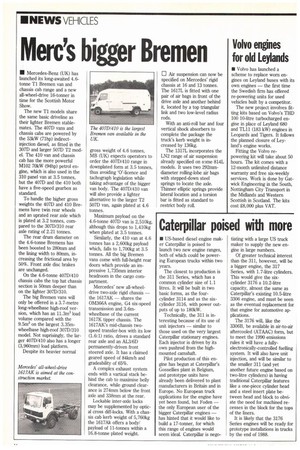Meres bigger Bremen
Page 16

If you've noticed an error in this article please click here to report it so we can fix it.
• Mercedes-Benz (UK) has launched its long-awaited 4.6tonne Ti Bremen van and chassis cab range and a new all-wheel-drive 16-tanner in time for the Scottish Motor Show.
The new Ti models share the same basic driveline as their lighter Bremen stablemates. The 407D vans and chassis cabs are powered by the 53kW (71hp) indirectinjection diesel, as fitted in the 307D and larger 507D T2 model. The 410 van and chassis cab has the more powerful M102 70kW (94hp) petrol engine, which is also used in the 310 panel van at 3.5 tonnes, but the 407D and the 410 both have a five-speed gearbox as standard.
To handle the higher gross weights the 407D and 410 Bremens have twin rear wheels and an uprated rear axle which is plated at 3.2 tonnes, compared to the 307D/310 rear axle rating of 2.21 tonnes.
The rear drum diameter on the 4.6-tonne Bremens has been boosted to 280nun and the lining width to 80nun, increasing the frictional area by 50%. Front axle disc brakes are unchanged.
On the 4.6-tonne 407D/410 chassis cabs the top hat chassis section is 50mm deeper than on the lighter 307D/310.
The big Bremen vans will only be offered in a 3.7-metre long-wheelbase high-roof version, which has an 11.3m3 load volume compared with the 9.5m3 on the largest 3.35mwheelbase high-roof 3071)/310 model. Not suprisingly, the larger 407D/410 also has a longer (3,960mm) load platform.
Despite its heavier normal gross weight of 4.6 tonnes, MB (UK) expects operators to order the 407D/410 range in downplated form at 3.5 tonnes, thus avoiding '0'-licence and tachograph legislation while taking advantage of the bigger van body. The 407D/410 van will also provide a lighter alternative to the larger T2 507D van, again plated at 4.6 tonnes.
Maximum payload on the 4.6-tonne 407D van is 2,510kg, although this drops to 1,410kg when plated at 3.5 tonnes.
Similarly, the 410 van at 4.6 tonnes has a 2,600kg payload which, falls to 1,700kg at 3.5 tonnes. All the big Bremen vans come with full-height rear doors which provide an impressive 1,735mm interior headroom in the cargo compartment.
Mercedes' new all-wheeldrive two-axle rigid chassis — the 1617AK — shares the 0M366A engine, G4 six-speed transmission and 3.6mwheelbase of the current 1617K tipper chassis. The 1617AK's mid-chassis twospeed transfer-box with its low (1.6:1) ratio, drives a standard rear axle and an AL3/6D permanently-driven front steered axle. It has a claimed geared speed of 841cm/h and gradeability of 65%.
A complex exhaust system ends with a vartical stack behind the cab to maximise belly clearance, while ground clearance is 274mm below the front axle and 338mm at the rear.
Lockable inter-axle locks may be supplemented by optical cross diff-locks. With a chassis cab kerb weight of 5,760kg the 1617Ak offers a body/ payload of 11-tonnes within a 16.8-tonne plated weight. Air suspension can now be specified on Mercedes' rigid chassis at 16 and 13 tonnes. The 1617L is fitted with one pair of air bags in front of the drive axle and another behind it, located by a top triangular link and two low-level radius rods.
With an anti-roll bar and four vertical shock absorbers to complete the package the truck's kerb weight is increased by 136kg.
The 1317L incorporates the LN2 range of air suspension already specified on some 814L models. It uses two 292mmdiameter rolling-lobe air bags with stepped-down steel springs to locate the axle. Thinner elliptic springs provide lateral location and a torsion bar is fitted as standard to restrict body roll.




































































































